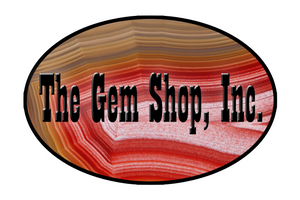History of Montana Moss Agate
Montana Moss Agate is found in the alluvial gravel pits of the Yellowstone River. In fact, this chalcedony river rock would probably be better named Yellowstone Agate because its creation is centered in the Yellowstone Park area. The volcanic activity that produced Montana Moss Agate actually spanned hundreds of miles and millions of years.
While the volcanic activity centered in the Yellowstone area of Montana and Wyoming, it ranged from the eastern Rock Mountains to the western part of the Black Hills, and north across Montana into Saskatchewan and Manitoba, Canada.
Montana Moss Agate was formed when eastern Montana was mostly a shallow inland ocean, almost swamp-like with forests lining the shores. The volcanos would spew forth lava entombing thousands of acres of forests in lava and ash. When the volcanos stopped erupting so frequently heavy rain came and sent silica-rich water into the layers of cavities left from the years of decaying trees and bubbling lava. Over time the mineral-laden silica water filled the pockets and Montana Agate was created.
The Yellowstone River is one of ten rivers in the world that runs south to north, instead of the opposite. It was originally called the Elk River by the early indigenous peoples and the Roche Jaune by the French. The Yellowstone is one of the last free-flowing rivers and from its headwaters in Yellowstone Lake runs 670 miles northeast to just south of Fort Buford, North Dakota, where it runs into the Missouri River. For many, this river is considered the life-blood of south-central and eastern Montana.
Montana Moss Formation Types
Montana Moss Agate can be found in three basic forms: nodules, geodes and limb casts. Each agate within each basic form has different patterns and pattern combinations unique to itself. Montana Moss Agate occurs most commonly as nodules and limb casts with only occasional geode-like formation found.
Layered Dendrite Agate Nodules: Layered dendrite type nodules were formed when progressive flows of silica filled cavities in minute layers with manganese and iron oxides getting trapped between the layers. This formed the ultra thin dendrites. Often the dendrites look like tree branches or moss clusters. In order to see the dendrites when cut, it is important to cut parallel with the layers. Only about 20% of layered agate nodules will contain dendritic layers, and of that 20% only about 1-2% will have quality dendrite layers that can be saved with clear milky white agate.
Ribbon Banded Agate Nodules: Full banded agates make sup a substantial percentage of the overall quantity of Montana Moss Agate nodules found. Traditionally, banded agates are cut perpendicular to the banding in order to show off the colorful patterns.
Ribbon Banded Limb-Casts: Banded limb-casts are similar in banding and internal patterns to the nodules, but the outside shape tends to be more round and elongated.
Thin Line Dendrite Limb-Casts & Nodules: Thin line dendrites can happen in both limb-casts and nodules. The dendritic layer tends to be the closest layer to where the chalcedony bands turned into quartz crystals at the center of the nodules or limb-cast. Thin line dendrites are different than the layered dendrites. A layered dendrite will be flat in appearance, while the thin line dendrite can appear more three-dimensional depending how the dendrite layer lies within the stone and how it is worked to follow the contours of the stone.
Thin Line Floating Dendrites: Most floating dendrites are not thin completely across the dendrites but have a strong center that appears to have depth, but then thins out to the edges. Traditionally, it is better to slowly grind away agate like this in order to expose the dendrites and not disk cutting through any of the center depth.
Full-Bodied Dendrites: Full-bodied dendrites can occur in both limb-casts and nodules. Key characteristics include dendrites that have a full-body center and lay in the agate in a fairly round shape when looking at them from the top. Looking at them from any other direction will slightly change she shape, but at the same time remain similar if cut from different directions.
Combination Dendrite and Banded Agate: Combination Montana Moss Agates contain any of the above mentioned banding and dendrites. In addition they can contain brown, black, orange, and red coloring. Combination agates count for roughly 30% of the Montana Moss Agates in production.
